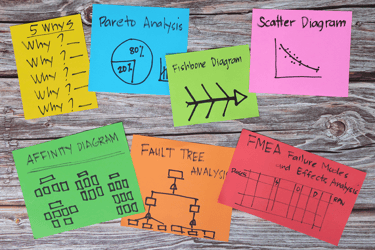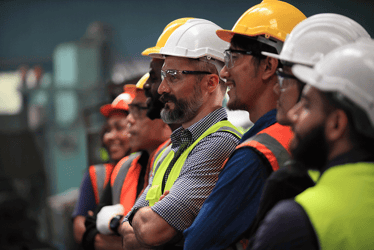The Packaging Industry's Sustainability Challenge: Why ERP Systems Are Essential for Success A straightforward guide to navigating sustainability regulations across folding carton, flexible...
7 innovative corrugated manufacturing wet end solutions you need to know
In the fast-paced world of corrugated manufacturing, staying ahead of the curve requires a mix of innovation, technology, and adaptability.
From evolving customer expectations to increased environmental pressures, manufacturers face numerous challenges that demand fresh solutions. One of the most critical areas for innovation is the wet end of the corrugator, the starting point of corrugated board production, where precision control and optimization can significantly impact overall product quality and cost-effectiveness.
Here are seven cutting-edge solutions transforming the corrugator's wet end, helping manufacturers tackle key production challenges.
Contents
- 1. Data-driven process control
- 2. Automated order changes
- 3. Advanced moisture control
- 4. Energy efficiency through optimized heating systems
- 5. Automated splicing and paper break detection
- 6. Closed-loop process control
- 7. Sustainability through waste reduction
- Embracing innovation for the future
1. Data-driven process control
Industry 4.0 has brought about a new era of data-driven manufacturing. At the wet end, real-time data is pivotal in monitoring and optimizing the entire production process. From controlling temperature and moisture levels to making pressure adjustments and receiving alerts for part replacements, real-time data empowers operators to make informed decisions.
By continuously gathering data on machine performance, predictive algorithms can foresee potential issues, allowing manufacturers to take proactive measures before production downtime occurs. This creates a more resilient and efficient production environment.
2. Automated order changes
Flexibility is essential in today’s market, where manufacturers must handle frequent order changes and smaller production runs. Automation at the wet end enables seamless transitions between jobs without sacrificing speed or quality.
Automation doesn’t just streamline the process; it enhances workforce productivity by allowing operators to focus on higher-value tasks like process optimization and quality assurance. Automated systems take over repetitive, time-consuming tasks, freeing up human resources for decision-making and strategic roles.
3. Advanced moisture control
Achieving the right moisture balance at the wet end is crucial for producing high-quality corrugated board. Excess moisture can lead to warping, while insufficient moisture causes brittleness and cracks. Advanced moisture control systems use real-time sensors to manage water and steam application, ensuring optimal bonding conditions. These systems allow machines to run faster while maintaining product integrity.
4. Energy efficiency through optimized heating systems
With rising energy costs and increased focus on sustainability, energy efficiency is a top priority for manufacturers. Optimized heating systems are designed to regulate steam usage at the wet end, reducing energy consumption while maintaining the necessary temperatures for bonding. Some systems even repurpose waste heat for other parts of the production process, cutting costs and supporting sustainability efforts.
5. Automated splicing and paper break detection
Downtime can have a significant impact on output and profitability. Automated splicing systems ensure a seamless transition from one roll of paper to the next, keeping the corrugator running without interruption. Advanced paper break detection technologies can identify issues quickly, helping operators resolve potential problems before they lead to costly downtime.
6. Closed-loop process control
Optimizing the corrugator requires that every step of the process works in harmony. At the wet end, synchronized control systems allow for real-time adjustments across various parameters, ensuring a consistent workflow. By reducing process variations, these systems prevent defects and ensure uniformity in the final product, while improving product quality and reducing waste.
7. Sustainability through waste reduction
As the packaging industry continues to prioritize sustainability, reducing waste at the wet end becomes increasingly important. Modern technologies optimize resource efficiency by controlling materials like adhesives and paper, ensuring only what’s needed is used. This approach helps manufacturers meet sustainability goals and lowers raw material costs.
Recently, FEPA has benefited from Escada’s Profile solution to ensure warp-free, high-quality board is produced. “Escada Profile has reduced our waste significantly, and our customers are delighted with the quality of the board we deliver” - Daniele Plazzi, Chief Innovation Officer at FEPA.
Embracing innovation for the future
The future of corrugated manufacturing lies in adopting these innovative technologies. By improving efficiency, cutting waste, and enhancing product quality, manufacturers can better navigate the demands of a constantly evolving market. The wet end of the corrugator, though just one part of the process, can become a hub of precision and productivity with the right solutions in place.
Ready to optimize your wet-end processes for a more efficient and sustainable manufacturing experience?
Solutions from ePS Escada, such as Syncro for automated order changes, HydroBalance for advanced moisture control, Energy for optimized heating, and Profile for closed-loop control, are helping manufacturers worldwide address these challenges. By embracing these innovations, you can enhance performance, achieve sustainability goals, and remain competitive in the ever-changing corrugated packaging industry, all while delivering the high-quality board your customers expect.




